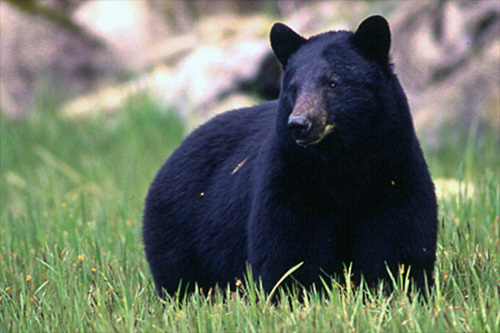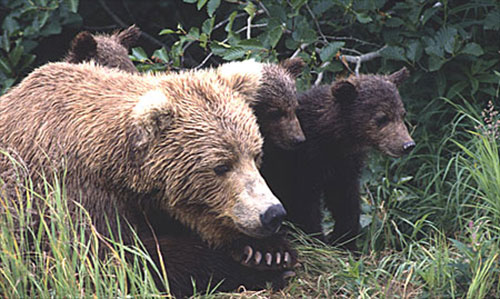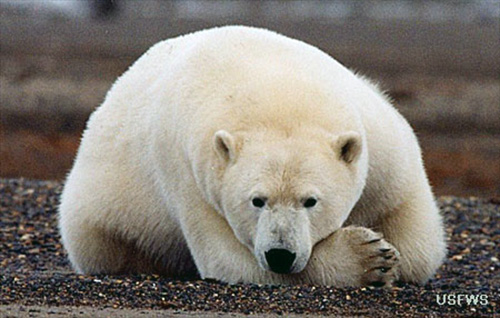
Recent Bear Maulings Bring Focus On Bear AwarenessBy MARY KAUFFMAN
June 26, 2017
The first fatal bear attack occurred Sunday, June 18th, during a popular running event near Bird Creek south of Anchorage. In the Bird Ridge fatal mauling, the Alaska Department of Fish & Game said a black bear believed responsible for that fatal mauling was among four bears shot and killed Tuesday evening, June 20th, by the staff. Small aircraft were used to locate the animals Tuesday after a ground search on Monday was unsuccessful.
Three other lone adult black bears were shot in close proximity to the Bird Ridge site of the attack in an effort to ensure the correct bear was killed. Extremely steep, rugged, brushy terrain made the use of tranquilizer darts impractical. In addition to a fixed-wing aircraft and a helicopter used by the department, Alaska Wildlife Troopers also planned to search for the bear, but were delayed when their helicopter was called to another matter. The second fatal mauling of a Pogo Mine contract employee by a black bear on Monday, June 19th, remains under investigation by the Alaska Department of Fish and Game. Early reports suggested the attack showed signs of being predatory, but biologists say further examination of events and the bear involved is needed before a definitive conclusion can be reached. Two Pogo Mine employees were reported attacked by the bear, one fatally, late Monday morning. The surviving employee was rescued by a mine helicopter after calling for help on a radio. Interviews after the incident indicate the bear broke off a subsequent attack on the survivor when the survivor deployed bear spray. The bear was said to have been killed by a mine employee who returned with a rifle. A department veterinarian who accompanied Alaska Wildlife Troopers to the scene to recover the bear carcass identified it as a cinnamon color-phase adult male. A necropsy has been performed on the bear and analysis is pending. Over the weekend, two more bear maulings thought to be defensive were reported The Alaska Dispatch News reported a man biking down a well-used gravel road was attacked by a brown bear near Clunie Lake in the Eagle River area Saturday morning. According to Alaska Dispatch News, Alaska Department of Fish and Game spokesman Ken Marsh said biologists are investigating the mauling. Based on initial information, they don't consider it a predatory attack but a "defensive attack" by a brown bear. This was one of two brown bear maulings Saturday. Seward Alaska State Troopers also received a report of a bear attack in Hope, Alaska south of Anchorage. Investigation revealed a 45 year old man from Hope, was walking on Palmer Creek Road when he came across a Sow Brown bear and cub. The bear was approximately 30 yards away when it charged him. The man told Troopers he tried to climb a tree but the bear swatted him out of the tree and injured him. The bear took off running into the woods with its cub. The bear did not return to the area. The man had minor injuries and he transported himself to the hospital. The Pogo Mine and Bird Ridge fatal attacks were considered to be predatory which are considered rare according to what Alaska Department of Fish and Game spokesman Ken Marsh told the Alaska Dispatch News.
Personal-use dipnetters camping and staging at the popular O'Brien Creek Campground to scoop up Copper River salmon have been reminded by Fish & Game they aren't the area's only fishers. Brown bears are in the area, too, and that's perfectly normal. But recent sightings, combined with news lately of two fatal bear attacks on humans elsewhere in Alaska, have some Alaska campers on edge. O'Brien Creek Campground is located in Chitina, Alaska. "We have a sow grizzly with two yearling cubs hanging around the campground," said Frank Robbins, Glennallen area wildlife biologist. "She was there last year and probably in prior years, too. For the most part she seems to be staying on the south side of the creek away from the campground and hasn't shown any overt signs of aggression." Robbins said the bears have not been getting into trash or camps and he believes they are drawn to the area by fish waste left in the shallows and along the banks of O'Brien Creek. He offers the following suggestions to prevent food-conditioning bears and avoid human-bear conflicts:
Wildlife managers generally divide bear attacks on humans into defensive and non-defensive (which includes predatory) categories. While bear attacks of any kind are relatively uncommon, predatory attacks on humans are rare. Of 207 bear attacks on humans recorded between 1980 and 2014 in Alaska, three were categorized as fatal predatory black bear attacks, according to retired state wildlife biologist John Hechtel. Ranging from Florida and Texas north to the Brooks Range, black bears are North America's most common bear species. Alaska's black bear population is estimated to be at least 100,000. Black bear hunting is allowed in the Pogo Mine and Bird Ridge areas. Bears may approach people out of curiosity, to test dominance, because they are food-conditioned or, rarely, because they are predatory. Interagency bear safety experts recommend people hiking, running or biking through bear country to carry a deterrent such as bear spray, or a firearm adequate for killing a bear. It is critical the deterrent be immediately within reach, where it can be quickly and easily accessed in the event of a sudden encounter. Female black bears generally keep their "yearling" offspring until about 18 months of life. June is usually when mother black bears forcefully encourage their young to become independent and fend for themselves. Yearling bears have long legs, appear skinny and many people think they are orphaned cubs; they are not. These young bears have learned feeding behavior from their mothers so it is important to prevent them from getting into human foods and garbage. Yearling black bears are still learning how to be "wild" bears and may be more visible to the public for a period of time. Never feed bears. Not only is it illegal, but it also creates future problems for both humans and bears. Quoting a news release from the Alaska Department of Fish & Game, when a bear is encountered at close range, people are advised to stand their ground, ready their deterrents, group up, and watch the bear. Stay firm and talk to the bear in a firm but calm voice. Don't play dead, run, or panic. If blocking the bear's path, try to move out of its way. If the bear continues to approach, follows, or is intent on a person, assert your dominance and become more aggressive. Don't retreat. Shout, make yourself look large, use your deterrent or, if you don't have a deterrent, throw rocks or sticks in an effort to drive off the bear. If the bear attacks, fight with anything you have, concentrating on the animal's face or muzzle.
The ADF&G estimates there are 100,000 black bears inhabiting Alaska. Black bears occur over most of the forested areas of the state; depending on the season of the year, they may be found from sea level to alpine areas. In Southeast Alaska, black bears occupy most islands, including Revillagigedo Island, an island in the Ketchikan Borough. With the exceptions of Admiralty, Baranof, Chichagof, and Kruzof; these islands are inhabited by brown bears. Both black and brown bear species occur on the southeastern mainland. Black bears can weigh up to 350 pounds. Balck bears are not found on the Seward Peninsula, on the Yukon-Kuskokwim Delta, or north of the Brooks Range. They are also absent from some of the large islands of the Gulf of Alaska, notably Kodiak, Montague, Hinchinbrook and others, and from the Alaska Peninsula south of the Lake Iliamna area. Brown bears (Ursus arctos), also known as grizzlies, occur throughout Alaska except on islands south of Frederick Sound in southeast Alaska, west of Unimak in the Aleutian Chain, and Bering Sea islands. Brown bears weigh up to 1,500 pounds. Although generally solitary in nature, brown bears often occur in large groups in concentrated feeding areas such as salmon spawning streams, sedge flats, open garbage dumps or on whale carcasses. Polar bears, closely related to brown bears, are the size of large brown bears. The largest males can weigh in excess of 1700 lbs, but the average is 600–1200 lbs and 8–10 feet in length. Adult females weigh 400–700 lbs. Polar bears occur throughout the northern polar region. In the winter, polar bears in Alaska are found as far south as St. Lawrence Island and occasionally move down to St. Matthew Island and the Kuskokwim Delta. In the summer, polar bears are most abundant around the edge of the pack ice in the Chukchi Sea and Arctic Ocean. In general, except for females with cubs, polar bears are solitary animals; however, marine mammal carcasses can attract large numbers of polar bears. Report aggressive bear behavior immediately to the Alaska Department of Fish and Game, or to Alaska Wildlife Troopers. To report an immediate public safety concern, dial 9-1-1.
On the Web:
Source of News:
Representations of fact and opinions in comments posted are solely those of the individual posters and do not represent the opinions of Sitnews.
|
|||||


